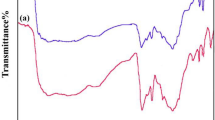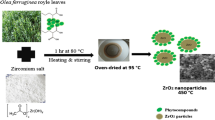Abstract
The present study analyzed on electrochemical performance of neem plant particles as an electrode material. The neem plant nano-sized particles are synthesized from neem leaves using a photon-induced method and their optical, structural properties, and morphology are analyzed. The appearance of nano-sized neem plant particles (Ns-NePPs) shows a broad absorption band found between ~ 340 and 800 nm in the UV–Vis spectrum. The band vibration of saponin, azadirachtin compound identified at 964 cm−1 in Fourier transforms infrared (FTIR) analysis and X-ray diffraction (XRD) pattern confirmed their crystalline nature with crystallite size of 22 nm. The scanning electron microscopy (SEM) image illustrates the spherical shape of Ns-NePPs with a size of 659 nm. The prepared neem electrode manifests the electrochemical redox peaks in cyclic voltammetry and chronopotentiometry analysis; it exhibits a notable specific capacitance of 157.36 F/g at a current density of 1 mA/s, and a good retention cyclic stability of 91.26% is suggested that could be utilized as energy storage material.







Similar content being viewed by others
References
Baig N, Kammakakam I, Falath W, Kammakakam I (2021) Nanomaterials: a review of synthesis methods, properties, recent progress, and challenges. Mater Adv 2:1821–1871. https://doi.org/10.1039/d0ma00807a
Torras M, Roig A (2020) From Silver plates to spherical nanoparticles : snapshots of microwave-assisted polyol synthesis. ACS Omega 5(11):5731–5738. https://doi.org/10.1021/acsomega.9b03748
Kannan K, Radhika D, Nesaraj AS, Revathi V, Sadasivuni KK (2020) A simple chemical precipitation of ceria based (Sm doped-CGO) nanocomposite: structural and electrolytic behaviour for LT-SOFCs. SN Appl Sci 2:1220. https://doi.org/10.1007/s42452-020-3035-2
Kannan K, Radhika D, Gnanasangeetha D, Sivarama Krishna L, Gurushankar K (2021) Y3+ and Sm3+ co-doped mixed metal oxide nanocomposite: structural, electrochemical, photocatalytic, and antibacterial properties. Applied Surface Science Advances 4:100085. https://doi.org/10.1016/j.apsadv.2021.100085
Nachimuthu S, Kannan K, Thangavel S, Gurushankar K (2022) Electrochemical and magnetic properties of 3D porous NiS/CuS nanocomposites. Applied Surface Science Advances 7:100209. https://doi.org/10.1016/j.apsadv.2022.100209
Rashad MM, Rayan DA, Turky AO, Hessien MM (2015) Effect of Co 2 + and Y 3 + ions insertion on the microstructure development and magnetic properties of Ni 0. 5 Zn 0. 5 Fe 2 O 4 powders synthesized using Co-precipitation method. J Magn Magn Mater 374:359–366. https://doi.org/10.1016/j.jmmm.2014.08.031
Wee C, Yen W, Chan S, Jeevanandam J, Pal K, Bechelany M (2019) Response surface methodology optimization of mono-dispersed MgO nanoparticles fabricated by ultrasonic-assisted sol – gel method for outstanding antimicrobial and antibiofilm activities. J Clust Sci 31:367–389. https://doi.org/10.1007/s10876-019-01651-3
Mohamed N, Othman R, Mubarak NM, Chan E (2017) Agricultural biomass-derived magnetic adsorbents : preparation and application for heavy metals removal. J Taiwan Inst Chem Eng 78:168–177. https://doi.org/10.1016/j.jtice.2017.05.023
Bayazit MK, Yue J, Cao E, Gavriilidis A, Tang J (2016) Controllable synthesis of gold nanoparticles in aqueous solution by microwave assisted flow chemistry controllable synthesis of gold nanoparticles in aqueous solution by microwave assisted flow chemistry. ACS Sustainable Chem Eng 4:6435–6442. https://doi.org/10.1021/acssuschemeng.6b01149
Nagaraj G, Mohammed MKA, Abdulzahraa HG, Sasikumar P, Karthikeyan S, Tamilarasu S (2021) Effects of the surface of solar-light photocatalytic activity of Ag-doped TiO2 nanohybrid material prepared with a novel approach. Appl Phys A Mater Sci Process 127:1–7. https://doi.org/10.1007/s00339-021-04427-7
Govindan N, Mohammed MKA, Tamilarasu S (2022) Nano-sized plant particles for next generation green-medicine. Mater Lett 309:131301. https://doi.org/10.1016/j.matlet.2021.131301
Jadoun S, Arif R, Jangid NK, Meena RK (2021) Green synthesis of nanoparticles using plant extracts: a review. Environ Chem Lett 19:355–374. https://doi.org/10.1007/s10311-020-01074-x
Choudhari AS, Mandave PC, Deshpande M, Ranjekar P, Salomone S (2020) Phytochemicals in cancer treatment : from preclinical studies to clinical practice. 10: 1–18https://doi.org/10.3389/fphar.2019.01614
Gurushankar K, Rimac H, Potemkin V, Grishina M (2021) Investigation of the newly characterized baimantuoluoamide a and baimantuoluoamide b alkaloids as potential cyclin-dependent kinase 4 (CDK4) inhibitors using molecular docking and molecular dynamics simulations. J Mol Struct 1230:129925. https://doi.org/10.1016/j.molstruc.2021.129925
Singh A, Neelam KM (2019) Physicochemical investigations of zinc oxide nanoparticles synthesized from Azadirachta indica (Neem) leaf extract and their interaction with calf-thymus DNA. Results Phys 13:102168. https://doi.org/10.1016/j.rinp.2019.102168
Kharwar RN, Sharma VK, Mishra A, Kumar J, Singh DK, Verma SK, Gond SK, Kumar A, Kaushik N, Revuru B, Kusari S (2020) Harnessing the phytotherapeutic treasure troves of the ancient medicinal plant azadirachta indica (neem) and associated endophytic microorganisms. Planta Med 86:906–940. https://doi.org/10.1055/a-1107-9370
Islas JF, Acosta E, Zuca GB, Delgado-Gallegos JL, Moreno-Treviño MR, Escalante B, Moreno-Cuevas JE (2020) An overview of neem (Azadirachta indica) and its potential impact on health. J Func Foods 74:104171. https://doi.org/10.1016/j.jff.2020.104171
Ali A, Shahid MA (2019) Polyvinyl Alcohol (PVA)–Azadirachta indica (neem) nanofibrous mat for biomedical application: formation and characterization. J Polym Environ 27:2933–2942. https://doi.org/10.1007/s10924-019-01587-9
Aadil M, Zulfiqar S, Shahid M, Haider S, Shakir I, Warsi MF (2020) Binder free mesoporous Ag-doped Co3O4 nanosheets with outstanding cyclic stability and rate capability for advanced supercapacitor applications. J Alloys Compd 844:156062. https://doi.org/10.1016/j.jallcom.2020.156062
Karuppaiah M, Sakthivel P, Asaithambi S, Murugan R, Yuvakkumar R, Ravi G (2019) Formation of one dimensional nanorods with microsphere of MnCO3 using Ag as dopant to enhance the performance of pseudocapacitors. Mater Chem Phys 228:1–8. https://doi.org/10.1016/j.matchemphys.2019.02.034
Hussain S, Wan P, Aslam N, Qiao G, Liu G, Wang M (2018) Ag-doped NiO porous network structure on Ni foam as electrode for supercapacitors. J Mater Sci: Mater Electron 29:1759–1765. https://doi.org/10.1007/s10854-017-8084-y
Jansi Rani B, Ravi G, Yuvakkumar R, Ameen F, AlNadhari S, Hong SI (2020) Fabrication and electrochemical OER activity of Ag doped MoO3 nanorods. Mater Sci Semicond Process 107:104818. https://doi.org/10.1016/j.mssp.2019.104818
Chen DR, Adusei PK, Chitranshi M, Fang Y, Johnson K, Schulz M, Shanov V (2021) Electrochemical activation to enhance the volumetric performance of carbon nanotube electrodes. Appl Surf Sci 541:148448. https://doi.org/10.1016/j.apsusc.2020.148448
Vijayakumar M, BharathiSankar A, Sri Rohita D, Rao TN, Karthik M (2019) Conversion of biomass waste into high performance supercapacitor electrodes for real-time supercapacitor applications. ACS Sustain Chem Eng 7:17175–17185. https://doi.org/10.1021/acssuschemeng.9b03568
Gonzalez Z, Yus J, Moratalla R, Ferrari B (2021) Electrophoretic deposition of binder-free TiN nanoparticles to design 3D microstructures. The role of sintering in the microstructural robustness of supercapacitor electrodes. Electrochimi Acta 369: 137654. https://doi.org/10.1016/j.electacta.2020.137654
Bai Z, Shen L, Wei J, Li Y, Abbas A, Li Y, Qu M, Zhang D, Zhang C (2020) Layered sulfur nanosheets prepared by assembly of sulfur quantum dots: implications for wide optical absorption and multiwavelength photoluminescence. ACS Appl Nano Mater 3:10749–10756. https://doi.org/10.1021/acsanm.0c02024
Chinnaiah K, Maik V, Kannan K, Potemkin V, Grishina M, Gohulkumar M, Tiwari R, Gurushankar K (2022) Experimental and theoretical studies of green synthesized Cu2O nanoparticles using datura metel L. J Fluoresc 32(2):559–568. https://doi.org/10.1007/s10895-021-02880-4
Fu X, Wu Q, Wang J, Chen Y, Zhu G (2021) Spectral characteristic, storage stability and antioxidant properties of anthocyanin extract from flowers of butterfly pea (Clitoria ternatea L.). Molecules 26: 7000. https://doi.org/10.3390/molecules26227000
Tahir MB, Asiri AM, Nabi G, Rafique M, Sagir M (2019) Fabrication of heterogeneous photocatalysts for insight role of carbon nanofibre in hierarchical WO3/MoSe2 composite for enhanced photocatalytic hydrogen generation. Ceram Int 45:5547–5552. https://doi.org/10.1016/j.ceramint.2018.12.012
He X, Yin L, Li Y (2019) Design of organic small molecules for photovoltaic application with high open-circuit voltage (Voc). J Mater Chem C 7:2487–2521. https://doi.org/10.1039/c8tc06589f
Tatarchuk T, Shyichuk A, Trawczyńska I, Yaremiy I, Pędziwiatr AT, Kurzydło P, Bogacz BF, Gargula R (2020) Spinel cobalt(II) ferrite-chromites as catalysts for H2O2 decomposition: synthesis, morphology, cation distribution and antistructure model of active centers formation. Ceram Int 46:27517–27530. https://doi.org/10.1016/j.ceramint.2020.07.243
Tatarchuk T, Danyliuk N, Shyichuk A, Macyk W, Naushad M (2021) Photocatalytic degradation of dyes using rutile TiO2 synthesized by reverse micelle and low temperature methods: real-time monitoring of the degradation kinetics. J Mol Liq 342:117407. https://doi.org/10.1016/j.molliq.2021.117407
Rangayasami A, Kannan K, Joshi S, Subban M (2020) Bioengineered silver nanoparticles using Elytraria acaulis (L.f.) Lindau leaf extract and its biological applications. Biocatal Agric Biotechnol 27: 101690. https://doi.org/10.1016/j.bcab.2020.101690
Tatarchuk T, Shyichuk A, Sojka Z, Gryboś J, Naushad M, Kotsyubynsky V, Kowalska M, Marks SK, Danyliuk N (2021) Green synthesis, structure, cations distribution and bonding characteristics of superparamagnetic cobalt-zinc ferrites nanoparticles for Pb(II) adsorption and magnetic hyperthermia applications. J Mol Liq 328:115375. https://doi.org/10.1016/j.molliq.2021.115375
Smith BAM, Eudoxie G, Stein R, Ramnarine R, Raghavan V (2020) Effect of neem leaf inclusion rates on compost physico-chemical, thermal and spectroscopic stability. Waste Manag 114:136–147. https://doi.org/10.1016/j.wasman.2020.06.026
Khaima W, Wan A, Khalir M, Shameli K, Jazayeri SD (2020) Biosynthesized silver nanoparticles by aqueous stem extract of entada spiralis and screening of their biomedical activity 8:1–15. https://doi.org/10.3389/fchem.2020.00620
Zia F, Ghafoor N, Iqbal M, Mehboob S (2016) Green synthesis and characterization of silver nanoparticles using Cydonia oblong seed extract. Appl Nanosci 6:1023–1029. https://doi.org/10.1007/s13204-016-0517-z
Starko I, Tatarchuk T, Bououdina M (2018) La-doped Ni0.5Co0.5Fe2O4 nanoparticles: effect of cobalt precursors on structure and morphology. Mol Cryst Liq Cryst 674:110–119. https://doi.org/10.1080/15421406.2019.1578517
Rawal S, Joshi B, Kumar Y (2018) Synthesis and characterization of activated carbon from the biomass of Saccharum bengalense for electrochemical supercapacitors. J Energy Storage 20:418–426. https://doi.org/10.1016/j.est.2018.10.009
Said Z, Sundar LS, Tiwari AK, Ali HM, Sheikholeslami M, Bellos E, Babar H (2021) Recent advances on the fundamental physical phenomena behind stability, dynamic motion, thermophysical properties, heat transport, applications, and challenges of nanofluids. Phys Rep 946:1–94. https://doi.org/10.1016/j.physrep.2021.07.002
Xie F, Zhou M, Wang G, Wang Q, Yan M, Bi H (2019) Morphology-dependent electrochemical performance of nitrogen-doped carbon dots@polyaniline hybrids for supercapacitors. Int J Energy Res 43:7529–7540. https://doi.org/10.1002/er.4678
Bencheikh Y, Harnois M, Jijie R, Addad A, Roussel P, Szunerits S, Hadjersi T, El Hak AS, Boukherroub R (2019) High performance silicon nanowires/ruthenium nanoparticles micro-supercapacitors. Electrochim Acta 311:150–159. https://doi.org/10.1016/j.electacta.2019.04.083
Tan DHS, Wu EA, Nguyen H, Chen Z, Adam M, Marple T, Doux J, Wang X, Yang H, Banerjee A, Meng YS (2019) Elucidating reversible electrochemical redox of Li6PS5Cl solid electrolyte elucidating reversible electrochemical redox of Li 6 PS 5 Cl solid electrolyte. ACS Energy Lett 4:2418–2427. https://doi.org/10.1021/acsenergylett.9b01693
Pandit B, Devika VS, Sankapal BR (2017) Electroless-deposited Ag nanoparticles for highly stable energy-efficient electrochemical supercapacitor. J Alloys Compd 726:1295–1303. https://doi.org/10.1016/j.jallcom.2017.08.068
Zhang X, Shi W, Zhu J, Kharistal DJ, Zhao W, Lalia BS, Hng HH, Yan Q (2011) High-power and high-energy-density flexible pseudocapacitor electrodes made from porous CuO nanobelts and single-walled carbon nanotubes. ACS Nano 5:2013–2019. https://doi.org/10.1021/nn1030719
Hou X-Y, Yan X-L, Wang X, Zhai Q-G (2018) Tuning the porosity of mesoporous NiO through calcining isostructural Ni-MOFs toward supercapacitor applications. J Solid State Chem 263:72–78. https://doi.org/10.1016/j.jssc.2018.04.009
Ren Q, Wu Z, Hu S, He L, Su S, Wang Y, Jiang L, Xiang J (2020) Sulfur self-doped char with high specific capacitance derived from waste tire: effects of pyrolysis temperature. Sci Total Environ 741:140193. https://doi.org/10.1016/j.scitotenv.2020.140193
Islam MR, Mollik SI (2020) Enhanced electrochemical performance of flexible and eco-friendly starch/graphene oxide nanocomposite. Heliyon 6:e05292. https://doi.org/10.1016/j.heliyon.2020.e05292
Yu B, Gele A, Wang L (2018) Iron oxide/lignin-based hollow carbon nanofibers nanocomposite as an application electrode materials for supercapacitors. Int J Biol Macromol 118:478–484. https://doi.org/10.1016/j.ijbiomac.2018.06.088
Biswas S, Chowdhury A, Chandra A (2019) Performance of Na-ion supercapacitors under non-ambient conditions—from temperature to magnetic field dependent variation in specific capacitance. Front Mater 6:54. https://doi.org/10.3389/fmats.2019.00054
Sharma V, Biswas S, Chandra A (2018) Need for revisiting the use of magnetic oxides as electrode materials in supercapacitors: unequivocal evidence of significant variation in specific capacitance under variable magnetic field. Adv Energy Mater 8:1800573. https://doi.org/10.1002/aenm.201800573
Sharma V, Singh I, Chandra A (2018) Hollow nanostructures of metal oxides as next generation electrode materials for supercapacitors. Sci Rep 8:1307. https://doi.org/10.1038/s41598-018-19815-y
Karthik K, Shashank M, Revathi V, Tatarchuk T (2018) Facile microwave-assisted green synthesis of NiO nanoparticles from Andrographis paniculata leaf extract and evaluation of their photocatalytic and anticancer activities. Mol Cryst Liq Cryst 673:70–80. https://doi.org/10.1080/15421406.2019.1578495
Amrutham S, Maragoni V, Guttena V (2020) One-step green synthesis of palladium nanoparticles using neem gum (Azadirachta Indica): characterization, reduction of rhodamine 6G dye and free radical scavenging activity. Appl Nanosci 10:4505–4511. https://doi.org/10.1007/s13204-020-01352-8
Acknowledgements
The authors (KC, KG) acknowledged Kalasalingam Academy of Research and Education, Krishnankoil, Tamilnadu, India.
Author information
Authors and Affiliations
Corresponding authors
Ethics declarations
Conflict of interests
The authors declare no competing interests.
Additional information
Publisher's note
Springer Nature remains neutral with regard to jurisdictional claims in published maps and institutional affiliations.
Rights and permissions
About this article
Cite this article
Nagaraj, G., K.Chinnaiah, Kannan, K. et al. Nano-sized neem plant particles as an electrode for electrochemical storage applications. Ionics 28, 3787–3797 (2022). https://doi.org/10.1007/s11581-022-04618-z
Received:
Revised:
Accepted:
Published:
Issue Date:
DOI: https://doi.org/10.1007/s11581-022-04618-z




